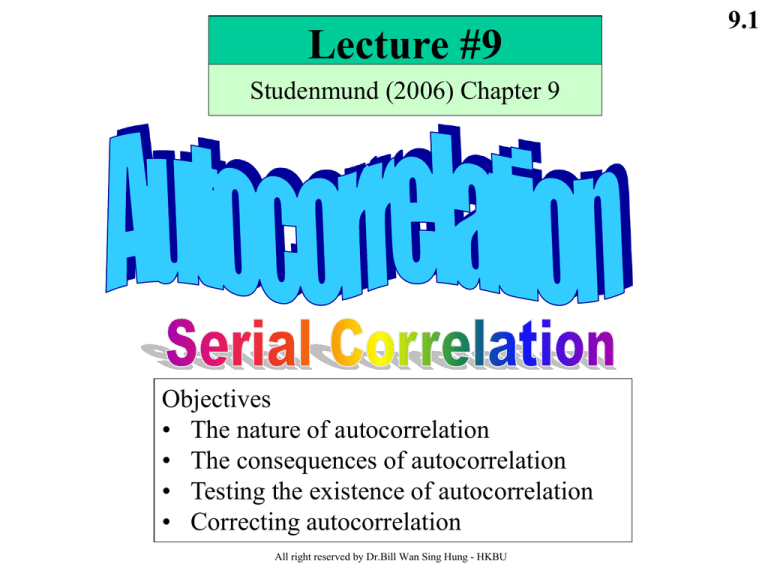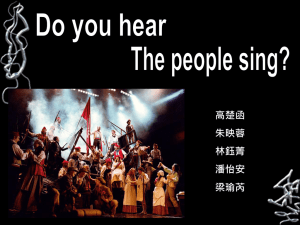
Lecture #9
Studenmund (2006) Chapter 9
Objectives
• The nature of autocorrelation
• The consequences of autocorrelation
• Testing the existence of autocorrelation
• Correcting autocorrelation
All right reserved by Dr.Bill Wan Sing Hung - HKBU
9.1
Time Series Data
Time series process of economic variables
e.g., GDP, M1, interest rate, exchange rate,
imports, exports, inflation rate, etc.
Realization
An observed time series data set generated
from a time series process
Remark:
Age is not a realization of time series process.
Time trend is not a time series process too.
All right reserved by Dr.Bill Wan Sing Hung - HKBU
9.2
9.3
Decomposition of time series
Xt = Trend + seasonal + random
Trend
Xt
Cyclical or
seasonal
random
time
All right reserved by Dr.Bill Wan Sing Hung - HKBU
Static Models
9.4
Ct = 0 + 1Ydt + t
Subscript “t” indicates time. The regression is a
contemporaneous relationship, i.e., how does
current consumption (C) be affected by current Yd?
Example: Static Phillips curve model
inflatt = 0 + 1unemployt + t
inflat: inflation rate
unemploy: unemployment rate
All right reserved by Dr.Bill Wan Sing Hung - HKBU
9.5
Finite Distributed Lag Models
Effect
at time t
Economic action
at time t
Effect
at time t+1
Effect
at time t+2
….
Effect
at time t+q
Forward Distributed Lag
Effect (with order q)
Ct =0+0Ydt+t
Ct+1=0+0Ydt+1+1Ydt+tCt=0 +0Ydt+1Ydt-1+t
….
Ct+q=0+1Ydt+q+…+1Ydt+tCt=0+1Ydt+…+1Ydt-q+t
All right reserved by Dr.Bill Wan Sing Hung - HKBU
9.6
Economic action
at time t
Effect
at time t-1
Backward Distributed Lag Effect
Effect
at time t-2
Effect
at time t-3
….
Effect
at time t-q
Yt= 0+0Zt+1Zt-1+2Zt-2+…+2Zt-q+t
Initial state: zt = zt-1 = zt-2 = c
All right reserved by Dr.Bill Wan Sing Hung - HKBU
C = 0 + 0Ydt + 1Ydt-1 + 2Ydt-2 + t
Long-run propensity (LRP) = (0 + 1 + 2)
Permanent unit change in C for 1 unit
permanent (long-run) change in Yd.
Distributed Lag model in
general:
Ct = 0 + 0Ydt + 1Ydt-1 +…+ qYdt-q
+ other factors + t
LRP (or long run multiplier) = 0 + 1 +..+ q
All right reserved by Dr.Bill Wan Sing Hung - HKBU
9.7
Time Trends
Linear time trend
Yt = 0 + 1t + t
9.8
Constant absolute change
Exponential time trend
ln(Yt) = 0 + 1t + t Constant growth rate
Quadratic time trend
Yt = 0 + 1t + 2t2 + t Accelerate change
For advances on time series analysis and modeling , welcome to take
ECON 3670
All right reserved by Dr.Bill Wan Sing Hung - HKBU
Definition: First-order of Autocorrelation, AR(1)
Yt = 0 + 1 X1t + t
t = 1,……,T
Cov (t, s) = E (t s) 0
If
and if
9.9
where t s
t = t-1 + ut
where
and
-1 < < 1
( : RHO)
ut ~ iid (0, u2) (white noise)
This scheme is called first-order autocorrelation and denotes as AR(1)
Autoregressive : The regression of t can be explained by
itself lagged one period.
(RHO) : the first-order autocorrelation coefficient
or ‘coefficient of autocovariance’
All right reserved by Dr.Bill Wan Sing Hung - HKBU
9.10
Example of serial correlation:
Year
1990
…
...
2002
2003
2004
2005
2006
2007
Consumptiont = 0 + 1 Incomet + errort
230
…
…
558
699
881
925
984
1072
320
…
…
714
822
907
1003
1174
1246
u1990
….
….
u2002
u2003
u2004
u2005
u2006
u2007
Error term
represents
other factors
that affect
consumption
TaxPay2006
TaxPay2007
The current year Tax Pay may be determined by previous year rate
TaxPay2007 =
TaxPay2006 + u2007
t = t-1 + ut
All right reserved by Dr.Bill Wan Sing Hung - HKBU
ut ~ iid(0, u2)
9.11
If t = 1 t-1 + ut
it is AR(1), first-order autoregressive
If t = 1 t-1 + 2 t-2 + ut
it is AR(2), second-order autoregressive
If t = 1 t-1 + 2 t-2 + 3 t-3 + ut
it is AR(2), third-order autoregressive
……………………………………………….
High order
autocorrelation
If t = 1 t-1 + 2 t-2 + …… + n t-n + ut
it is AR(n), nth-order autoregressive
Autocorrelation AR(1) :
-1 < < 1
Cov (t t-1) > 0
=> 0 < < 1
positive AR(1)
Cov (t t-1) < 0
=> -1 < < 0
negative AR(1)
All right reserved by Dr.Bill Wan Sing Hung - HKBU
^
i
Positive autocorrelation
Positive autocorrelation
^
i
x
x
x
x
x
x
x
x
x
0
x
time 0
x
x
x
^
i
time
x
x
x
9.12
x
Cyclical: Positive autocorrelation
x
x
0
x
x
x
xx
x
x
x
x
x
x
x
x
x
time
All right reserved by Dr.Bill Wan Sing Hung - HKBU
The current error
term tends to have
the same sign as
the previous one.
9.13
^
i
Negative autocorrelation
x
x
x
x
x
x
x
x
x
time
x
x
x
x
x
The current error term tends to have the opposite sign from the previous.
^
i
x
0
No autocorrelation
x
x x x x x
x
x x x
x
x
x
x
x
x
x
xx
x x
x x
x
x
time
The current error term tends to be randomly appeared from the previous.
All right reserved by Dr.Bill Wan Sing Hung - HKBU
The meaning of : The error term t at time t is a linear
combination of the current and past disturbance.
0<<1
-1 < < 0
The further the period is in the
past, the smaller is the weight of
that error term (t-1) in
determining t
=1
The past is equal importance to
the current.
>1
The past is more importance than
the current.
All right reserved by Dr.Bill Wan Sing Hung - HKBU
9.14
9.15
The consequences of serial correlation:
1. The estimated coefficients are still unbiased.
^ )=
E(
k
BLUE
k
^
2. The variances of the k is no longer the smallest
^
3. The standard error of the estimated coefficient, Se(k)
becomes large
Therefore, when AR(1) is existing in the regression,
The estimation will not be “BLUE”
All right reserved by Dr.Bill Wan Sing Hung - HKBU
Example: Two variable regression model: Yt = 0 + 1X1t + t
9.16
xy
^
The OLS estimator of 1, ===> 1 =
xt2
If
E(t t-1) = 0
then
2
^)=
Var (
1
xt2
If E(tt-1) 0, and t = t-1 + ut , then
2
22
xt xt+1 2 xt xt+2
^
+ ….
Var (1)AR1=
+
+
2
2
2
2
xt
xt
xt
xt
-1 < < 1
If = 0, zero autocorrelation, than Var(^1)AR1 = Var(^1)
^
^
If 0, autocorrelation, than Var(1)AR1 > Var(1)
The AR(1) variance is not the smallest
All right reserved by Dr.Bill Wan Sing Hung - HKBU
9.17
Autoregressive scheme:
t = t-1 + ut
==> t-1 = t-2 + ut-1
==> t-2 = t-3 + ut-2
==> t = [ t-2 + ut-1] + ut
t = 2 t-2 + ut-1 + ut
=> t = 2 [ t-3 + ut-2] + ut-1 + ut
t = 3 t-3 + 2 ut-2 + ut-1 + ut
2
E(t t-1) =
1 - 2
E(t t-2) = 2
E(t t-3) = 2 2
…………….
E(t t-k) = k-1 2
It means the more periods in the past,
the less effect on current period
k-1 becomes smaller and smaller
All right reserved by Dr.Bill Wan Sing Hung - HKBU
How to detect autocorrelation ?
DW* or d*
All right reserved by Dr.Bill Wan Sing Hung - HKBU
9.18
5% level of significance,
k = 1,
n=24
dL = 1.27
du = 1.45
DW* = 0.9107
DW* < dL
k is the number of
independent variables
(excluding the intercept)
All right reserved by Dr.Bill Wan Sing Hung - HKBU
9.19
Durbin-Watson Autocorrelation test
9.20
From OLS regression result: where d or DW* = 0.9107
Check DW Statistic Table (At 5% level of significance, k’ = 1, n=24)
H0 : no autocorrelation
=0
H1 : yes, autocorrelation exists.
or > 0
positive autocorrelation
dL = 1.27
du = 1.45
Reject
H0
region
dL
0
1.27
du
1.45
2
DW*
0.9107
All right reserved by Dr.Bill Wan Sing Hung - HKBU
9.21
Durbin-Watson test
Y = 0 + 1 X2 + …… + k Xk + t
obtain ^
t ,
DW-statistic(d)
OLS :
Assuming AR(1) process: t = t-1 + ut
I.
-1 < < 1
H0 : ≤ 0
no positive autocorrelation
H1 : > 0
yes, positive autocorrelation
DW*
Compare d* and dL, du (critical values)
if d* < dL
==> reject H0
if d* > du
==> not reject H0
if dL d* du ==> this test is inconclusive
All right reserved by Dr.Bill Wan Sing Hung - HKBU
9.22
Durbin-Watson test(Cont.)
T
DW =
( d)
(^t - ^
t-1)2
^
d 2(1-)
2 (1 - ^)
t=2
T
^
t2
t=1
^
d ≈ 2 (1- )
d
≈ 1 - ^
2
==> ^
≈ 1- d
2
==>
^ 1
Since -1
implies 0 d 4
dL
0
1.27
du
1.45
2
(4-dU)
(4-dL)
2.55
2.73
All right reserved by Dr.Bill Wan Sing Hung - HKBU
4
9.23
Durbin-Watson test(Cont.)
II.
H0 : ≥0
H1 : < 0
no negative autocorrelation
yes, negative autocorrelation
we use (4-d)
(when d is greater than 2)
if (4 - d) < dL
or 4 - dL < d < 4
==> reject H0
if dL (4 - d) du
or 4 - du d 4 - dL ==> inconclusive
if dL (4 - d) du
or 4 - du > d > 2
dL
0
1.27
==> not reject H0
du
1.45
2
All right reserved by Dr.Bill Wan Sing Hung - HKBU
(4-dU)
(4 - dL)
2.55
2.73
4
Durbin-Watson test(Cont.)
II.
H0 : =0
No autocorrelation
H1 : 0
If d < dL
or d > 4 - dL
two-tailed test for auto correlation
either positive or negative AR(1)
==> reject H0
If
du < d < 4 - du ==> not reject H0
If
dL d du
or 4 - du d 4 - dL
==> inconclusive
All right reserved by Dr.Bill Wan Sing Hung - HKBU
9.24
9.25
For example :
^ = 23.1 - 0.078 CAP - 0.146 CAP + 0.043T
UM
t
t
t-1
t
(15.6) (2.0)
(3.7)
(10.3)
_
^ = 0.677 SSR = 29.3 DW = 0.23 n = 68
R2 = 0.78 F = 78.9
(i)
Observed
K = 3 (number of independent variable) (excluding intercept)
(ii) n = 68 ,
(iii) dL = 1.525 ,
dL = 1.372 ,
= 0.01
0.05
du = 1.703
du = 1.546
significance level
0.05
0.01
Reject H0, positive autocorrelation exists
All right reserved by Dr.Bill Wan Sing Hung - HKBU
H0 : = 0
positive autocorrelation
H1 : > 0
reject
H0
H0 : = 0
negative autocorrelation
H1 : < 0
not
reject
0
du
1.372
1.525
1.546
1.703
reject
H0
not
reject
inconclusive
dL
9.26
inconclusive
2
4-du
4-dL
2.45
2.297
2.63
2.475
0.23
All right reserved by Dr.Bill Wan Sing Hung - HKBU
4
DW
(d)
1% & 5%
Critical values
9.27
The assumptions underlying the d(DW) statistics :
1. Intercept term must be included.
2. X’s are nonstochastic
3. Only test AR(1) : t = t-1 + ut
where ut ~ iid (0, u2)
4. Not include the lagged dependent variable,
Yt = 0+ 1 Xt1 + 2 Xt2 + …… + kXtk + Yt-1 + t
Y
100
...
...
20
N.A.
N.A.
37
41
...
...
1980
235
81
N.A.
missing
82
N.A.
93
253
94
281
95
All right reserved by Dr.Bill Wan Sing Hung - HKBU
X
15
...
(autoregressive model)
5. No missing observation
1970
Lagrange Multiplier (LM) Test or called Durbin’s m test
Or Breusch-Godfrey (BG) test of higher-order autocorrelation
Test Procedures:
(1) Run OLS and obtain the residuals ^t.
(2) Run ^t against all the regressors in the model
plus the additional regressors, ^t-1, ^t-2, ^t-3,…, ^t-p.
^t = 0 + 1 Xt + ^
t-1 + ^t-2 + ^t-3 + … + ^t-p + u
Obtain the R2 value from this regression.
(3) compute the BG-statistic: (n-p)R2
(4) compare the BG-statistic to the 2p (p is # of degree-order)
(5) If BG > 2p, reject Ho,
it means there is a higher-order autocorrelation
If BG < 2p, not reject Ho,
it means there is a no higher-order autocorrelation
All right reserved by Dr.Bill Wan Sing Hung - HKBU
9.28
Remedy: 1. First-difference transformation
Yt = 0 + 1 Xt + t
Yt-1 = 0 + 1 Xt-1 + t-1
9.29
assume = 1
==> Yt - Yt-1 = 0 - 0 + 1 (Xt - Xt-1) + (t - t-1)
==>
DYt =
1 DXt + t
no intercept
2. Add a trend (T)
Yt = 0 + 1 Xt + 2 T + t
Yt-1 = 0 + 1 Xt-1 + 2 (T -1) + t-1
==> (Yt - Yt-1) = (0 - 0) + 1 (Xt - Xt-1) + 2 [T- (T -1)] + (t - t-1)
==> DYt = 1 DXt + 2*1 + ’t
==> DYt = 2* + 1 DXt + ’t
If ^
1* > 0 => an upward trend in Y
^
(2 > 0) All right reserved by Dr.Bill Wan Sing Hung - HKBU
3. Cochrane-Orcutt Two-step procedure (CORC)
(1). Run OLS on
and obtains ^
t
(2). Run OLS on
and obtains ^
Yt = 0 + 1 Xt + t
^
t = ^t-1 + ut
Where u~(0, )
Generalized
Least Squares
(GLS)
method
(3). Use the ^ to transform the variables :
Yt* = Yt - ^ Yt-1
Xt* = Xt - ^
Xt-1
(4). Run OLS on
9.30
Yt = 0 + 1 Xt + t
^ t-1
-) ^
Yt-1 = 0 ^ + 1 ^ Xt-1 +
^ t-1)
^ +1(Xt - ^Xt-1) + (t -
(Yt - ^Yt-1)= 0(1-)
Yt* = 0* + 1* Xt* + ut
All right reserved by Dr.Bill Wan Sing Hung - HKBU
4. Cochrane-Orcutt Iterative Procedure
(5). If DW test shows that the autocorrelation still existing, than
it needs to iterate the procedures from (4). Obtains the t*
(6). Run OLS
^
t* = ^t-1* + ut’
DW2
^
^
(1 )
2
^
and obtains ^
which is the second-round estimated
^
(7). Use the ^
to transform the variable
^
Yt** = Yt - ^
Yt-1
Yt = 0 + 1 Xt + t
^ X
Xt** = Xt - ^
t-1
^
^
^
^
^ t-1 + ^
^
Yt-1 = 0 ^
+ 1 X
t-1
All right reserved by Dr.Bill Wan Sing Hung - HKBU
9.31
Cochrane-Orcutt Iterative procedure(Cont.)
(8). Run OLS on
Where is
Yt** = 0** + 1** Xt** + t**
^
^
^
^
^
^
^
^
(Yt - Yt-1) = 0 (1 - ) + 1 (Xt - Xt-1) + (t - t-1)
(9). Check on the DW3 -statistic, if the autocorrelation is still
existing, than go into third-round procedures and so on.
^ ^
^
^ < 0.01).
^-
Until the estimated ’s differs a little (
All right reserved by Dr.Bill Wan Sing Hung - HKBU
9.32
Example: Studenmund (2006) Exercise 14 and Table 9.1, pp.342-3449.33
(1)
Low DW statistic
Obtain the
Residuals
(Usually after you
run regression, the
residuals will be
immediately stored
in this icon
All right reserved by Dr.Bill Wan Sing Hung - HKBU
(2)
9.34
Give a new name
for the residual series
Run regression of the
current residual on
the lagged residual
ˆt ˆt -1 t
Obtain the
^
estimated ρ(“rho”)
All right reserved by Dr.Bill Wan Sing Hung - HKBU
(3)
Transform the Y* and X*
New series are created,
but each first observation
is lost.
All right reserved by Dr.Bill Wan Sing Hung - HKBU
9.35
(4)
Run the
transformed
regression
Obtain the estimated result
which is improved
All right reserved by Dr.Bill Wan Sing Hung - HKBU
9.36
(5)~(9)
9.37
The Cochrane-Orcutt Iterative procedure in the EVIEWS
The is the EVIEWS’
Command to run the
iterative procedure
All right reserved by Dr.Bill Wan Sing Hung - HKBU
The result of the Iterative procedure
9.38
This is the
estimated ρ
Each
variable
is
transformed
The DW
is improved
All right reserved by Dr.Bill Wan Sing Hung - HKBU
9.39
Generalized least Squares (GLS)
5. Prais-Winsten transformation
Yt = 0 + 1 Xt + t
t = 1,……,T
Assume AR(1) : t = t-1 + ut
(1)
-1 < < 1
Yt-1 = 0 + 1 Xt-1 + t-1
(2)
(1) - (2) => (Yt - Yt-1) = 0 (1 - ) + 1 (Xt - Xt-1) + (t - t-1)
GLS
=> Yt* = 0* + 1* Xt* + ut
All right reserved by Dr.Bill Wan Sing Hung - HKBU
9.40
To avoid the loss of the first observation, the first
observation of Y1* and X1* should be transformed as :
^2 (Y )
Y1* = 1 -
1
^2 (X )
X1* = 1 -
1
but Y2* = Y2 - ^
Y1 ; X2* = X2 - ^ X1
…...
…...
…...
…...
…...
…...
Y3* = Y3 - ^ Y2 ; X3* = X3 - ^ X2
Yt* = Yt - ^ Yt-1 ; Xt* = Xt - ^ Xt-1
All right reserved by Dr.Bill Wan Sing Hung - HKBU
Edit the
figure here
To restore
the first
observation
Yt = 0 + 1 Xt + t
6. Durbin’s Two-step method :
Since (Yt - Yt-1) = 0 (1 - ) + 1 (Xt - Xt-1) + ut
=> Yt = 0* + 1 Xt - 1 Xt-1 + Yt-1 + ut
I. Run OLS => Y = * + * X - * X + * Y + u
0
1
t
2
t-1
3
t-1
t
this specification t
Obtain
^3* as an estimated ^
(RHO)
II. Transforming the variables :
Yt* = Yt - ^3* Yt-1
and Xt* = Xt - ^3* Xt-1
as Yt* = Yt - ^Yt-1
^X
as X * = X -
t
t
t-1
III. Run OLS on model : Yt* = 0 + 1 Xt* + ’t
^0 = ^0 (1 - ) and ^1 = ^1
where
All right reserved by Dr.Bill Wan Sing Hung - HKBU
9.41
9.42
Including this
lagged term of Y
Obtain the estimated
^
ρ(“rho”)
All right reserved by Dr.Bill Wan Sing Hung - HKBU
Limitation of Durbin-Watson Test:
9.43
Lagged Dependent Variable and Autocorrelation
Yt = 0 + 1 X1t + 2 X2t + …… + k Xk.t + 1 Yt-1 +t
DW statistic will often be closed to 2 or
DW is not reliable
DW does not converge to 2 (1 - ^)
Durbin-h Test:
Compare h* to Z
If
Compute
h*
=^
n
1 - n*Var (^1)
where Zc ~ N (0,1) normal distribution
|h*| > Zc => reject H0 : = 0 (no autocorrelation)
All right reserved by Dr.Bill Wan Sing Hung - HKBU
Durbin-h Test:
Compute
h* = ^
n
9.44
1 - n*Var (^1)
24
h* 0.7772*
1 - 24 * (0.10617) 2
h* = 4.458 > Z
Therefore reject
H0 : = 0 (no autocorrelation)
All right reserved by Dr.Bill Wan Sing Hung - HKBU








